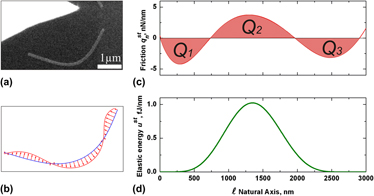Crossref Citations
This article has been cited by the following publications. This list is generated based on data provided by
Crossref.
Polyakov, Boris
Dorogin, Leonid M.
Vlassov, Sergei
Kink, Ilmar
Romanov, Alexey E.
and
Lohmus, Rynno
2012.
Simultaneous measurement of static and kinetic friction of ZnO nanowires in situ with a scanning electron microscope.
Micron,
Vol. 43,
Issue. 11,
p.
1140.
Polyakov, Boris
Dorogin, Leonid M
Lohmus, Ants
Romanov, Alexey E
and
Lohmus, Rynno
2012.
In situ measurement of the kinetic friction of ZnO nanowires inside a scanning electron microscope.
Applied Surface Science,
Vol. 258,
Issue. 7,
p.
3227.
Polyakov, B.
Dorogin, L.M.
Vlassov, S.
Antsov, M.
Kulis, P.
Kink, I.
and
Lohmus, R.
2012.
In situ measurements of ultimate bending strength of CuO and ZnO nanowires.
The European Physical Journal B,
Vol. 85,
Issue. 11,
Polyakov, Boris
Vlassov, Sergei
Dorogin, Leonid M.
Kulis, Peteris
Kink, Ilmar
and
Lohmus, Rynno
2012.
The effect of substrate roughness on the static friction of CuO nanowires.
Surface Science,
Vol. 606,
Issue. 17-18,
p.
1393.
Dorogin, Leonid M.
Vlassov, Sergei
Polyakov, Boris
Antsov, Mikk
Lõhmus, Rünno
Kink, Ilmar
and
Romanov, Alexey E.
2013.
Real‐time manipulation of ZnO nanowires on a flat surface employed for tribological measurements: Experimental methods and modeling.
physica status solidi (b),
Vol. 250,
Issue. 2,
p.
305.
Kim, Hyun-Joon
Kang, Kyeong Hee
and
Kim, Dae-Eun
2013.
Sliding and rolling frictional behavior of a single ZnO nanowire during manipulation with an AFM.
Nanoscale,
Vol. 5,
Issue. 13,
p.
6081.
Antsov, Mikk
Dorogin, Leonid
Vlassov, Sergei
Polyakov, Boris
Vahtrus, Mikk
Mougin, Karine
Lõhmus, Rünno
and
Kink, Ilmar
2014.
Analysis of static friction and elastic forces in a nanowire bent on a flat surface: A comparative study.
Tribology International,
Vol. 72,
Issue. ,
p.
31.
Guo, Wanlin
Yin, Jun
Qiu, Hu
Guo, Yufeng
Wu, Hongrong
and
Xue, Minmin
2014.
Friction of low-dimensional nanomaterial systems.
Friction,
Vol. 2,
Issue. 3,
p.
209.
Hou, Lizhen
Wang, Shiliang
and
Huang, Han
2015.
A simple criterion for determining the static friction force between nanowires and flat substrates using the most-bent-state method.
Nanotechnology,
Vol. 26,
Issue. 16,
p.
165702.
Tran, D. K.
and
Chung, K.-H.
2015.
Simultaneous Measurement of Elastic Properties and Friction Characteristics of Nanowires Using Atomic Force Microscopy.
Experimental Mechanics,
Vol. 55,
Issue. 5,
p.
903.
Polyakov, Boris
Dorogin, Leonid
Vlassov, Sergei
Kink, Ilmar
and
Lõhmus, Rünno
2015.
Fundamentals of Friction and Wear on the Nanoscale.
p.
395.
Xie, Hongtao
Wang, Shiliang
and
Huang, Han
2015.
Kinetic and static friction between alumina nanowires and a Si substrate characterized using a bending manipulation method.
Journal of Materials Research,
Vol. 30,
Issue. 11,
p.
1852.
Kim, Hyun-Joon
Nguyen, Gia Hau
Ky, Dinh Le Cao
Tran, Da Khoa
Jeon, Ki-Joon
and
Chung, Koo-Hyun
2016.
Static and kinetic friction characteristics of nanowire on different substrates.
Applied Surface Science,
Vol. 379,
Issue. ,
p.
452.
Xie, Hongtao
Wang, Shiliang
and
Huang, Han
2016.
Characterising the nanoscale kinetic friction using force-equilibrium and energy-conservation models with optical manipulation.
Nanotechnology,
Vol. 27,
Issue. 6,
p.
065709.
Vlassov, Sergei
Polyakov, Boris
Oras, Sven
Vahtrus, Mikk
Antsov, Mikk
Šutka, Andris
Smits, Krisjanis
Dorogin, Leonid M
and
Lõhmus, Rünno
2016.
Complex tribomechanical characterization of ZnO nanowires: nanomanipulations supported by FEM simulations.
Nanotechnology,
Vol. 27,
Issue. 33,
p.
335701.
Lusiola, Tony
and
Clemens, Frank
2016.
Nanoscale Ferroelectrics and Multiferroics.
p.
232.
Roy, Aditi
Mead, James
Wang, Shiliang
and
Huang, Han
2017.
Effects of surface defects on the mechanical properties of ZnO nanowires.
Scientific Reports,
Vol. 7,
Issue. 1,
Xie, Hongtao
Mead, James
Wang, Shiliang
and
Huang, Han
2017.
The effect of surface texture on the kinetic friction of a nanowire on a substrate.
Scientific Reports,
Vol. 7,
Issue. 1,
Xie, Hongtao
Wang, Shiliang
and
Huang, Han
2018.
Effects of Surface Roughness on the Kinetic Friction of SiC Nanowires on SiN Substrates.
Tribology Letters,
Vol. 66,
Issue. 1,
Xie, Hongtao
Mead, James L
Wang, Shiliang
Fatikow, Sergej
and
Huang, Han
2018.
Characterizing the surface forces between two individual nanowires using optical microscopy based nanomanipulation.
Nanotechnology,
Vol. 29,
Issue. 22,
p.
225705.





